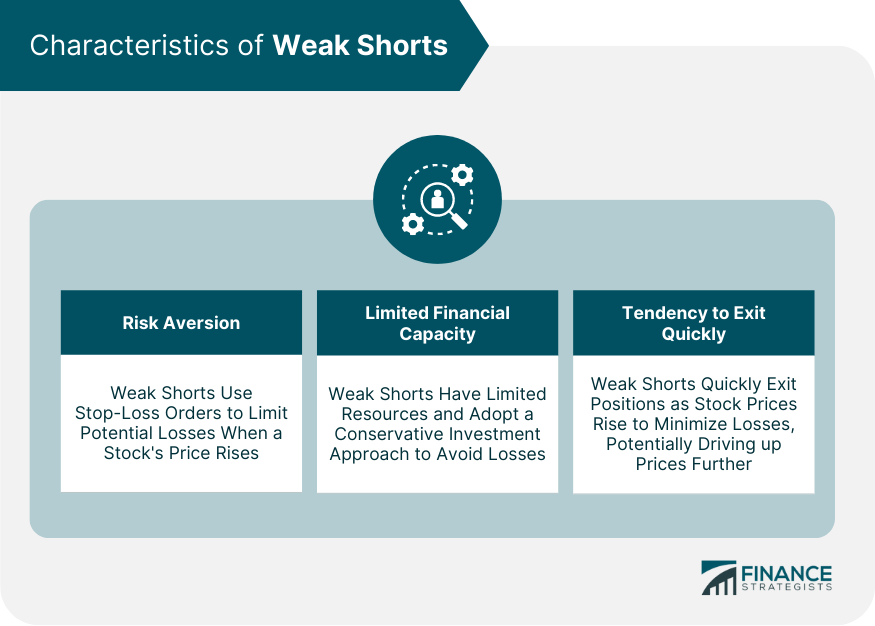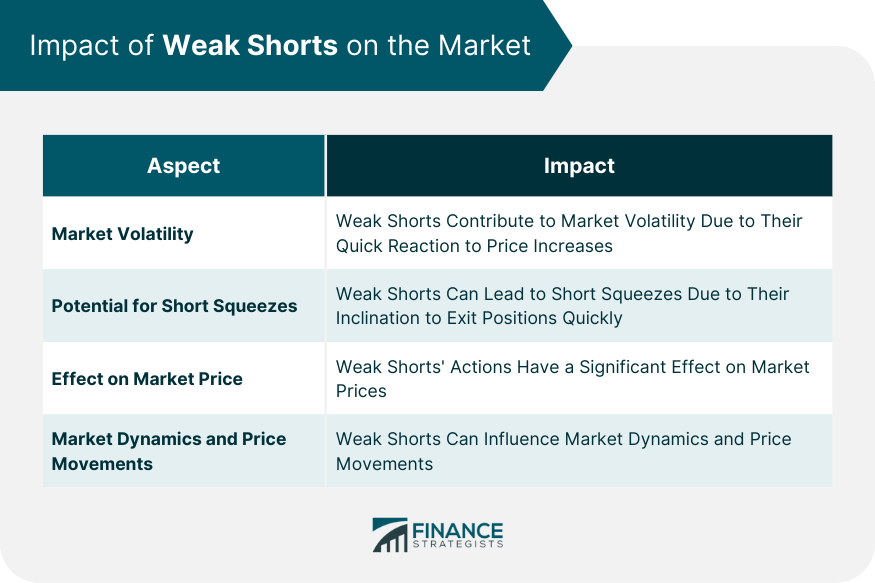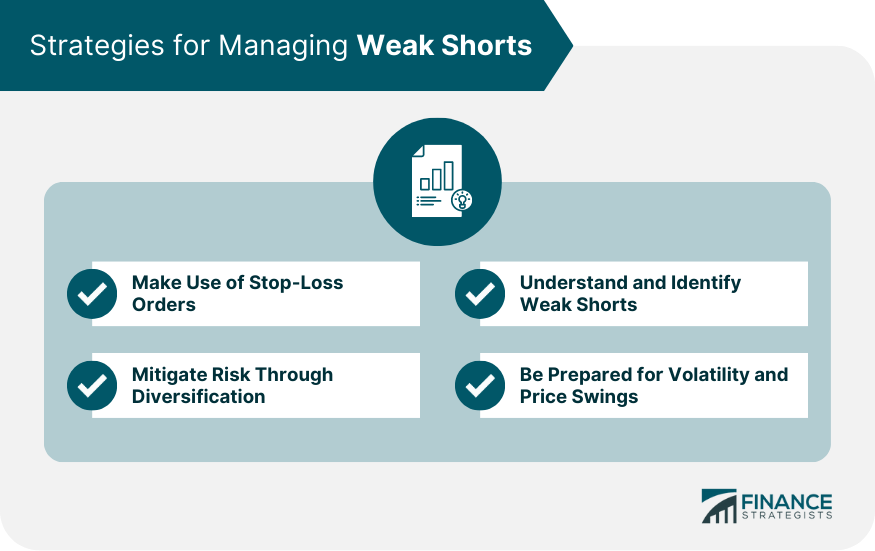Weak shorts are risk-averse traders who hold a short position in stocks or other financial assets, prone to exit their positions at the earliest sign of price strength. Their conservative investment strategies focus primarily on minimizing losses. To this end, they often use stop-loss orders to protect against significant financial downturns during unpredictable market fluctuations. While this approach may limit potential profit, it acts as a shield against substantial financial loss. Although weak shorts and their counterparts, weak longs, bet on opposite price movements, they share a key attribute: a cautious approach that prioritizes cutting losses quickly when the market turns unfavorable. Understanding the philosophy and mindset of these investors is critical in assessing their impact on financial markets. Short selling is a trading strategy where an investor borrows shares of a stock from a broker and sells them in the open market, betting that the stock's price will decline. The investor then plans to buy back the stock at a lower price, return the borrowed shares to the broker, and pocket the difference. The potential for profit in short selling is substantial, but so are the risks, given the potential for limitless losses if the stock's price increases instead of decreasing as expected. Short selling can be an effective strategy for profiting from a declining market or individual stocks. However, this strategy is fraught with substantial risks. Since there's no limit to how high a stock's price can rise, potential losses from short selling are technically unlimited. Furthermore, the investor must eventually return the borrowed shares, which could lead to additional costs if the price increases. On the positive side, short selling allows traders to profit from declining prices, providing a hedge when markets are falling. Short selling can also expose overpriced stocks, contributing to market efficiency. In the world of short selling, weak shorts play a crucial role. Given their risk-averse nature, they act as a counterbalance to more aggressive short sellers. Weak shorts can serve as an early warning system for a potential reversal in price trends. When weak shorts start exiting their positions, it may signal that the stock's price is about to increase. One defining characteristic of weak shorts is their risk-averse nature, which often manifests in the frequent use of stop-loss orders. These orders, placed with a broker, automatically trigger a buy order if the stock's price rises to a pre-determined level. This practice helps weak shorts manage their risks effectively by capping potential losses. Another key characteristic of weak shorts is their typically limited financial capacity. These investors cannot absorb substantial losses, leading them to adopt a more conservative approach to their investments. This financial constraint often leads weak shorts to prefer stocks with smaller price swings, reducing the potential for severe financial loss. Weak shorts are known for their propensity to exit positions quickly when a stock's price begins to rise. This tendency is driven by their risk-averse nature and the desire to minimize losses. When weak shorts begin exiting their positions, it often creates a cascade effect, with the price of the stock potentially rising even further as more weak shorts cover their positions. Weak shorts contribute to market volatility due to their quick reaction to price increases. When a stock's price begins to rise and weak shorts exit their positions, it can create a surge in demand for the stock. This increased demand can lead to larger price swings, creating a more volatile market environment. Short squeezes are market scenarios where a stock's price rises rapidly, forcing short sellers to buy the stock to cover their short positions, which in turn drives the price even higher. Due to their tendency to rapidly close out their positions when prices rise, weak short sellers can play a role in starting short squeezes. The actions of weak shorts can have a significant effect on market prices. As they exit their positions during price increases, the demand for the stock rises, potentially driving the price even higher. Conversely, their initial selling can contribute to downward pressure on a stock's price. Consequently, weak shorts can significantly influence market dynamics and price movements. Bullish traders, who believe that a stock's price will rise, can exploit the behaviors of weak shorts. For instance, they can buy stocks with high short interest, anticipating that a price rise will trigger weak shorts to exit their positions, creating additional buying pressure and further increasing the price. Essentially, weak shorts can inadvertently act as catalysts for bullish traders' strategies. A high level of short interest—meaning many shares have been sold short—can have a profound effect on weak shorts. The higher the short interest, the greater the potential for a short squeeze, which could lead to rapid price increases. This scenario is particularly precarious for weak shorts, which may be forced to exit their positions sooner than expected, contributing to the intensity of the price rise. Bullish traders may monitor the behavior of weak shorts as part of their strategy. When weak shorts begin to exit their positions, it can signal a possible increase in the stock's price. Understanding the behavior of weak shorts allows bullish traders to time their trades more effectively, potentially enhancing their profits. Weak shorts are more common among retail traders compared to institutional investors. Retail traders, who generally have limited financial resources, often adopt a risk-averse approach similar to that of weak shorts. In addition, the ease of implementing stop-loss orders in retail trading platforms makes this strategy more accessible to retail traders. Institutional investors, with their vast financial resources, can absorb larger losses than retail traders. Therefore, they're less likely to adopt the risk-averse weak short strategy. Instead, institutional investors may utilize more sophisticated strategies, such as hedging their positions to manage risk. This contrast highlights the different strategies and risks appetites of institutional and retail traders. Retail traders can use the behavior of weak shorts to their advantage. By identifying stocks with high short interest and a large presence of weak shorts, they can anticipate potential short squeezes or price rises. Armed with this knowledge, retail traders can position themselves to profit from these market dynamics. Stop-loss orders are crucial for managing the risks associated with being a weak short. They limit potential losses by automatically triggering a buy order when a stock's price rises to a predetermined level. The effective use of stop-loss orders allows weak shorts to control their risk and protect their financial resources. In addition to using stop-loss orders, weak shorts can manage their risk by diversifying their investment portfolio and not overly concentrating on short positions. By investing in a range of assets, weak shorts can spread their risk, reducing the potential impact of a single failed short position. For other traders, understanding the behavior of weak shorts can provide valuable insights. Identifying stocks with a high presence of weak shorts can signal potential trading opportunities. Additionally, traders should be aware of the volatility and rapid price swings that can occur when weak shorts begin to exit their positions. Being prepared for these dynamics can help traders navigate the market more effectively. Weak Shorts are risk-averse investors who prioritize limiting losses over seeking high returns. They maintain a short position in a financial asset but exit promptly if prices show strength. These investors are defined by their risk aversion, quick exit strategies during price increases, and frequent use of stop-loss orders. Their behavior can significantly influence market dynamics, contributing to volatility and possibly sparking short squeezes. However, risks associated with weak shorts can be managed and potentially exploited through strategies such as using stop-loss orders effectively, diversifying portfolios, and understanding the market dynamics they induce. It's crucial to comprehend the inherent risks in any investment strategy for successful investing. If you require assistance in understanding the complexities of financial markets and tailoring a strategy to your risk tolerance, consider engaging professional wealth management services. This way, you can make well-informed decisions to reach your financial goals.What Are Weak Shorts?
Detailed Understanding of Short Selling
Explanation of Short Selling: Concept and Process
Risks and Benefits of Short Selling
Role of Weak Shorts in Short Selling
Characteristics of Weak Shorts
Risk Aversion and Stop-Loss Orders
Limited Financial Capacity: Impact on Trading Strategy
Tendency to Exit Quickly During Price Increase

Impact of Weak Shorts on the Market
Role of Weak Shorts in Creating Volatility
Potential for Short Squeezes Due to Weak Shorts
Effect of Weak Shorts on Market Price

Relationship Between Weak Shorts and Bullish Traders
How Bullish Traders Can Exploit Weak Shorts
Impact of High Short Interest on Weak Shorts
Influence of Weak Shorts on Bullish Trading Strategies
Weak Shorts in the Context of Retail and Institutional Investors
Prevalence of Weak Shorts Among Retail Traders
Contrast Between Weak Shorts in Institutional and Retail Trading
How Retail Traders Can Benefit From the Behavior of Weak Shorts
Strategies for Managing Weak Shorts
Importance of Stop-Loss Orders for Weak Shorts
How Weak Shorts Can Mitigate Risk and Manage Losses
Advice for Traders Dealing With Weak Shorts

Final Thoughts
Weak Shorts FAQs
Weak Shorts are traders who hold a short position in a stock or other financial asset and are quick to exit their positions at the first sign of a price increase.
Weak Shorts contribute to market volatility due to their tendency to quickly exit their positions when a stock's price starts to rise, which can drive the price even higher and cause large price swings.
Weak Shorts can contribute to short squeezes, which occur when a stock's price rises rapidly, forcing short sellers, including weak shorts, to buy the stock to cover their positions, pushing the price even higher.
Weak Shorts often employ stop-loss orders, which automatically trigger a buy order when the stock's price rises to a certain level. This allows them to cap their losses and manage their risk effectively.
By recognizing the behavior of Weak Shorts, traders can anticipate potential price surges and manage their own strategies accordingly. High short interest combined with the presence of weak shorts can be a signal for potential trading opportunities.
True Tamplin is a published author, public speaker, CEO of UpDigital, and founder of Finance Strategists.
True is a Certified Educator in Personal Finance (CEPF®), author of The Handy Financial Ratios Guide, a member of the Society for Advancing Business Editing and Writing, contributes to his financial education site, Finance Strategists, and has spoken to various financial communities such as the CFA Institute, as well as university students like his Alma mater, Biola University, where he received a bachelor of science in business and data analytics.
To learn more about True, visit his personal website or view his author profiles on Amazon, Nasdaq and Forbes.











